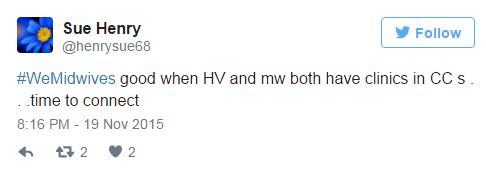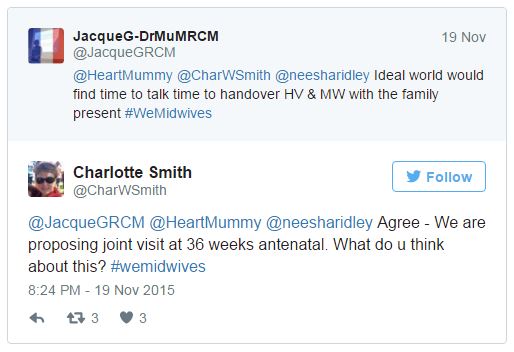As I mentioned in my round up of #OxyOct for the #MatExp campaign, Sheena Byrom very kindly invited me to host a #WeMidwives Twitter chat on the subject of collaboration between midwives and health visitors. A new pathway for Health Visiting and Midwifery partnership was recently launched by Public Health England, and with the CPHVA conference underway in Manchester last week it seemed an ideal time to discuss this. The topic has already been covered here for #MatExp and the campaign includes many dedicated and passionate professionals from both midwifery and health visiting. So on Thursday evening of last week we kicked off “Midwives and Health Visitors – let’s connect!”

Before opening the questions, I posted a link to this blog by health visitor Jenny Harmer, as it is an excellent explanation of the role of the health visitor and what they actually do. Misunderstandings or lack of knowledge about the role of the HV are a key barrier to parents approaching them for support, and to other professions signposting to them.

My first question was:
Midwives and Health Visitors, how do you work together in your communities and ensure smooth handovers for families?
There were certainly areas of best practice:




And pretty quickly the idea of joint training arose:

It seems to be the case that teams who started on Baby Friendly pathways some time ago already train their midwives and health visitors together, as this used to be sensible for the original BFI standards. Although BFI no longer works that way, the teams are still collaborating in these areas.

Where the individual teams are based was also discussed:


This was a theme that emerged at a #MatExp meet up a few of us had in Manchester earlier in the week. Teams that are co-located will naturally find it easier to build relationships and collaborate. However, separate building need not necessarily be a barrier to teamwork.

Children’s Centres were identified as one of the obvious places where midwives and health visitors can physically work together, although I did point out that in many areas (including my own) Children’s Centres are being closed down at an alarming rate.

Question 2:
How are antenatal visits from health visitors impacting on collaboration? Do these happen in your area?
The health visitors I have spoken to are overwhelmingly in favour of the new antenatal visits, as they provide an opportunity for the HV to build a relationship with a family before the baby arrives. A baseline for mental health can be obtained and important issues discussed before the parents enter the fog of the newborn weeks. As the families are under the care of their midwives at this point, surely it makes sense for some of these visits and contacts to be undertaken together?



Issues of time available, size of caseload and the individual needs and wishes of families were brought up. There is no “one size fits all” solution here – for some families a joint antenatal visit would be inappropriate – but having the option available would be a positive. And having teams working closely enough together to make it a possibility would benefit all families.
Question 3:
What are your thoughts on the new pathway, is it achievable?


Whilst the pathway provides a standard to work towards, it might be that the individual relationships and local networks are not yet at a point where it is realistic for all. Always with the #MatExp focus on individual ACTION in my mind, my fourth question was:
What can individual professionals do to improve their working relationships between midwifery and health visiting teams?

Again we came back to the lack of understanding amongst parents of the role of the health visitor, and how midwives can help to ensure that families don’t miss out on vital HV support.

The discussion ran on into the following day as individuals continued to explore themes raised during the hour. It became very clear that, whilst services are overstretched and morale can be low due to pressures within, there are professionals who are passionate about collaborative working. Those people can encourage their colleagues to reach out to other professions, and to put families at the centre. Spread the word!




Join the conversations taking place on Facebook and Twitter, and in your own homes, wards and offices. Join like-minded professionals who are keen to push things forward for the families they support. All aboard the #MatExp train!
